
|   |

|   |
Nayika seminar in Hyderabad - Tapati Chowdhurie e-mail: tapatichow@yahoo.co.in April 15, 2016 Kuchipudi scholar, choreographer, mentor, therapist and performer Vyjayanthi Kashi, Artistic Director of Shambhavi School of Dance (Bangalore), has initiated research on the contribution made by women in Kuchipudi dance form, which has historically been the stronghold of male dancers. To this effect, she held the third edition of Nayika seminar at Shilparamam in Hyderabad early in March. The first two editions were held in Bengaluru and Chennai respectively. Vyjayanthi Kashi is a seeker of knowledge on Kuchipudi. As a person from Karnataka with a great thirst to know all that needs to be known about Kuchipudi and not schooled in the Telugu language, all that she got to know were through translations, where she had heard names like Kanchanamala, Shanti Vedantam and others. She held the third edition of Nayika in Hyderabad to hear stalwarts in Kuchipudi speak of their experiences. Though belonging to Bengaluru, she was keen to hold the Nayika Festival in Hyderabad, as past experience has revealed to her, that it would be difficult for stalwarts like Dr. K. Uma Rama Rao, Kanchanamala, Shanti Vedantam to travel outside Hyderabad. A seminar held on the 6th of March on “Contribution of women to Kuchipudi” started at 10am, but the intensity of interaction caused by the outpourings of the rich experiences of the speakers, made it go on till late afternoon and had to end perforce in favour of lunch and the evening dance recital. The formal lighting of the lamp and Archana (the Master of Ceremonies) introduced the moderator Dr. Aruna Bhikshu, who cut a long story short and said, “Today women are responsible for the survival of Kuchipudi and it has become pan-Indian because of women,” and speaker Dr. K. Uma Rao, who has put in seven decades of her service to dance, took to the dais. The founder of her school Lasya Priya, where she teaches both Bharatanatyam and Kuchipudi, she began her story: “I had an obsession for dance from early childhood.” While in Chennai-known as Madras those days - she had the chance of a lifetime to see Ramgopal, Gopinath - Thangamani, Rukmini Devi and Uday Shankar dance. She was inspired by them. She danced for the joy of dancing, oblivious of what style the dance form was. Seeing her interest in dance her father invited dance and music gurus to come to their sprawling mansion in Hyderabad to give her and her sister Sumathi, formal lessons in dance. She learnt pada varnams and jathiswaram from Guru Nataraja Ramakrishna. Those were the days when they called classical dance Bharatam. So it was Kuchipudi Bharatam and Tanjavur Bharatam referring to Kuchipudi and Bharatanatyam dance forms. Kuchipudi was accepted in the classical fold as late as 1957. In the year 1953, Vedantam Lakshminarayana Sastry was invited to be their guru. Within a short span of time, he taught them Manduka and Dasavatara sabdams. He taught them Bhama Kalapam. A master of abhinaya, this guru who always kept a low profile is credited to have taught dancers like Balasaraswati, Mylapore Gowri Amma, Ramiah Pillai and others, the art of emoting. She finished her thesis on Yakshagana Prabandhas of Shahji in 1994 which earned her a doctorate degree in Kuchipudi, getting a gold medal for it to boot. Like a teenage girl basking in the laurels won, she showed us a paragraph written glowingly in Telugu by her guru Vedantam Lakshminarayana Sastry in her autograph book, foretelling a great future in her career as a dancer. Her guru was as obsessed about teaching his ace pupil to dance as she was. So much so that he allowed her little chance to go out or indulge in any other activity. She is one of the foremost nayikas of Kuchipudi. She was inducted as a professor of dance in Thyagraja Government College in 1969 and continued there till 1988 and became an Associate Professor in Potti Sriramulu Telegu University in Hyderabad. A creative artist par excellence, she has composed a number of solos as well dance dramas in traditional Yakshaganas based on the lyrics of great composers and contemporary writers. 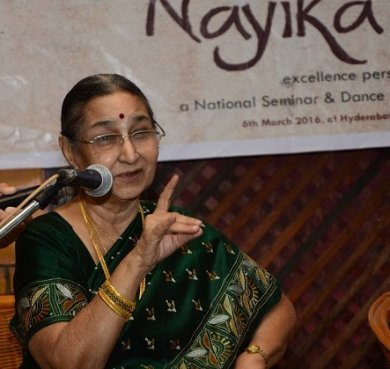 Dr. Uma Rama Rao 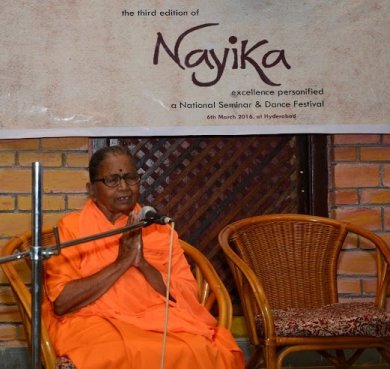 Kanchanamala Octogenarian Kanchanamala dressed in saffron clothes was a personification of humility when she was helped to take her seat, from where she was going to speak. She was all too enthusiastic to share her experiences with an equally enthusiastic crowd of connoisseurs. A direct disciple of Vedantam Lakshminarayana Sastry, she confessed that her obsession with dance initiated her into it. She was all praise for her guru who lived from 1880 to 1957, and who is credited with many a first. He was a visionary leader of the contemporary Kuchipudi dance world and encouraged and introduced girls to learn the art of Kuchipudi. For his disciple Kanchanamala, he designed a costume which had to have a huge ‘pallau’ or ‘anchal’ needed for Bhamakalapam, which would eventually become the Kuchipudi costume to be worn by women. He was the first to introduce the practice of presenting individual items of dance. He thus built up a huge repertory of solo dances and gave solo dance its rightful place. He enjoys the singular credit of supplying a performance manual for each of the compositions he has choreographed. It was almost like a word to word description of the performance. This gave scope to his disciples the method of choreographing a given text. Nayika Kanchanamala said in no uncertain terms that Kuchipudi rendered in the correct spirit could elevate the audience to higher realms of human existence. Her Guru Vedantam Lakshminarayana Sastry laid the foundation of abhinaya in her, while she learnt pure dance from the Tanjore Quartet. She recounted an incident that took place on March 31, 1958, when she was scheduled to present a dance recital at the first All-India Dance Seminar, held in India’s new capital, New Delhi. Upon arriving at the seminar, however, she was informed by the organizers that her evening slot had been cancelled. Instead, she and her co-delegate from Andhra Pradesh, scholar and political figure, Vissa Appa Rao (1884–1966), were requested to present a lecture-demonstration as part of the daytime program. According to contemporary sources such as newspaper articles and radio broadcasts, Kanchanamala and Appa Rao felt insulted and condescended to by the organizers at the 1958 Seminar, in particular, by chairpersons and important nationalist figures Rukmini Devi Arundale (1904–1986) and V. Raghavan (1908–1979), first by being demoted to the daytime program and then by being treated with disrespect during their presentation. The Telugu dance style Kuchipudi was declared as folk at the Seminar. “By extension, Telugus were relegated to the margins of an emerging Indian modernity, in which classicism was increasingly defined as historicism, if not history itself.” (From ‘Between History and Historiography: The origins of classical Kuchipudi Dance’). Kanchanamala was not going to be deterred. She insisted on presenting what she had come prepared for. This controversy was flashed in the Hindu. Kanchanamala was a veritable store-house of knowledge. She spoke at length about everything that mattered in shaping the Kuchipudi classical dance form. She spoke at length about Vinayak tala and explained its intricacies by drawing a pen picture of Vinayaka much to the amazement of the audience. Dr. Rajyalakshmi Seth, the next speaker, has made her own contribution to the enrichment of Kuchipudi dance. Seth was never a performer. “Circumstances pushed me into dance,” and so rather than becoming a performer, she chose to indulge in dance activities. Having learnt 45 variety of steps, she set up her dance school Muvva Kuchipudi Dance Training Centre in Bombay, after her marriage in 1981, at the behest of her husband. In Bombay at that time there was no one to do nattuvangam and so she could easily fill in the gap. Here, she taught dance to local aspirants. She was always fascinated by the multi-dimensional changes in Kuchipudi. She collected books and resources and published works and completed her research in 2005. Gauging her perspective, she was given a senior fellowship by the Union Ministry of Tourism and Culture for Kuchipudi dance to work on Sabdams in the Kuchipudi repertoire. Speaker Shanti Vedantam is the first female dancer from the traditional family of the Vedantams to learn Kuchipudi. The granddaughter of Vedantam Lakshminarayana Sastry, she was taught meticulously by her father Vedantam Jagannadha Sastry and has performed as Mohini in Ksheerasagara Manthanam, as Usha in Usha Parinayam and as Lukma Devi in Karpura Vasanta Rayalu. She has also taught Kuchipudi and shared her experiences with the assembled and demonstrated a dance. 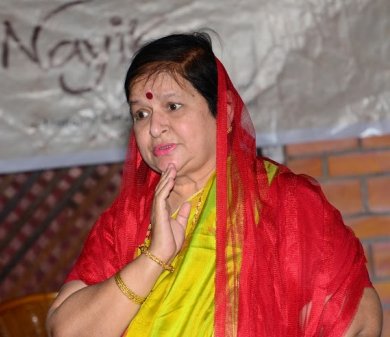 Shanti Vedantam 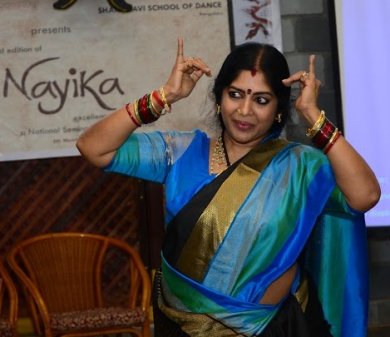 Alekhya Punjala 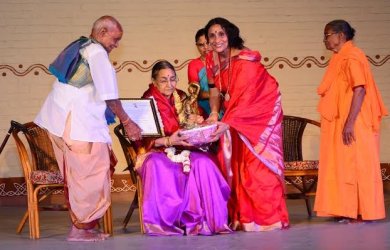 Dr. Uma Rama Rao receives Natya Sastra Award 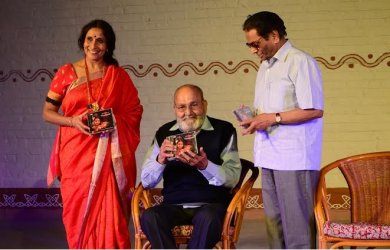 Release of the DVD Alekhya Punjala, a disciple of Dr. Uma Rao, spoke glowingly about her teacher. She is a professor of dance and has earned fame through her impeccable abhinaya. To sum it all up, the names that made a difference was given due places. Today, no one can deny the difference made by women in Kuchipudi. It is through a woman’s body that the form has to survive. For her immense contribution to Kuchipudi dance, Dr. Uma Rama Rao was conferred the Natya Sastra Award. The release of the DVD, The Magic of Kuchipudi, featuring Prateeksha Kashi was released soon after. Pasumarti Sashi Babu sang Ganapati Stuti followed by Guru Pranam and Devi Stuti. The actual performance commenced with the Bharatanatyam performance of Lata Surendra who is a performer, teacher, choreographer and researcher. She selected a piece from the 12th century poet Akka Mahadevi’s vachanas. Akka Mahadevi is from Udutadi in Karnataka. She was an ardent lover of Shiva. Her Shiva, who was Channamallikarjuna, had triggered in her a poetic overflow expressing her deep love for him. The king had fallen in love with Akka Mahadevi and parental pressure made her agree to the marriage with a promise from the king. However the king broke his promise, upon which she left him to unite with her lord Channamallikarjuna. The story was that of a woman who knew her mind and no earthly pressure could pin her down. Lata has taken the form forward innovatively, while at the same time keeping to the basics of Bharatanatyam.  Lata Surendra  Prateeksha Kashi Prateeksha Kashi, daughter and disciple of Vyjayanti Kashi, is a talented performer and has imbibed the form at quite an early age. She was Rudramma Devi, the Kakatiya queen. The story of Rudramma is like the story of the Manipuri princess Chitrangada, who had to take up the reins of the kingdom because of the lack of a male heir who could be the king. She commended herself with extreme grace and beauty which are the hallmarks of the form. A good deal of power dancing by Prateeksha Kashi endeared her to the audience. Her postures and steps befitted the role she was depicting. Her bearing had the regality of a queen, bravery of a soldier in battle, kindness of a motherly figure to her subjects and so on. Most of the supporting dancers were from Vyjayanti’s school in Dharwar and they were good dancers. Kathak recital of Mangala Bhatt from Jaipur brought the day long festival to an end. She chose to perform Mahalakshmi Astakam taken from Padmapuranam. Apart from displaying her qualities in nritta portions, her selection of the astapadi “Yahi Madhava, yahi Kesava” from Jayadeva’s Geeta Govinda was emoted realistically. Betrayal of Krishna and its effect on Radha showed maturity. Nayika was supported by the Ministry of Culture, Government of India. Tapati Chowdurie learnt dance for almost 10 years from Guru Gopinath in his dance institution Natana Niketan in Madras. For a brief period, she was with International Centre for Kathakali in New Delhi. Tapati has a Master's degree in English Literature and Bachelor's degree in Education. She has a regular column in The Statesman, where she writes on dance and music. Presently, she is a freelance writer. |